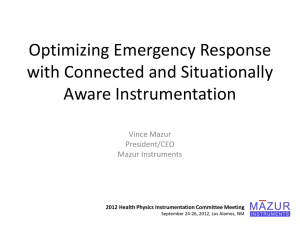NetCAM HPIC 2012
advertisement
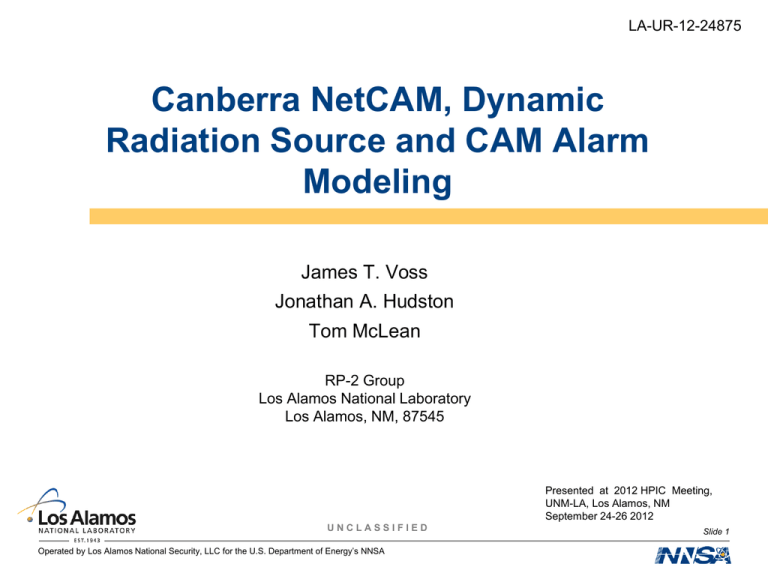
LA-UR-12-24875 Canberra NetCAM, Dynamic Radiation Source and CAM Alarm Modeling James T. Voss Jonathan A. Hudston Tom McLean RP-2 Group Los Alamos National Laboratory Los Alamos, NM, 87545 Presented at 2012 HPIC Meeting, UNM-LA, Los Alamos, NM September 24-26 2012 UNCLASSIFIED Operated by Los Alamos National Security, LLC for the U.S. Department of Energy’s NNSA Slide 1 Introduction: Outline Introduction • • • Evaluation recap Evaluation update Suggested areas for future improvement Current NetCAM performance • Alarm algorithms and set points — • Alarm modeling Dynamic radiation source testing Conclusions UNCLASSIFIED Operated by Los Alamos National Security, LLC for the U.S. Department of Energy’s NNSA Slide 2 Introduction Canberra NetCAM evaluation began 9/2008 at LANL • • Selected as candidate for continuous air monitor at the RLUOB facility Perceived advantages of NetCAM dongle over ASM1000 — — — Immediate problems found with: • • • • • Cost ($3.5 K cheaper than ASM1000) Networking capability (built-in web browser) Peak-shape fitting algorithm included Hardware Firmware User interface Intra and Inter-communications Documentation incomplete Spent next 3.5 years resolving these issues UNCLASSIFIED Operated by Los Alamos National Security, LLC for the U.S. Department of Energy’s NNSA Slide 3 Introduction NetCAM dongle • Up to 8 CAM heads can be connected — • • • • but 1:1 configuration selected for RLUOB RS-232 output to PC ( terminal emulator) console program RJ-45 ethernet connections (unit has built-in web browser) Remote monitoring using RadHawk (RadNet-compliant) listener Has wireless capability too ( not used at LANL) AS1700 CAM head • • • • 1700 mm2 PIPs detector Efficiency of ~32% for electroplated distributed 239Pu source Flow rates ~ 2cfm Original firmware: version 1.10 (now have 2.4) UNCLASSIFIED Operated by Los Alamos National Security, LLC for the U.S. Department of Energy’s NNSA Slide 4 Canberra NetCAM Panel PC functions as local display (runs embedded Win XP) Dongle configuration 2 RJ-45 ports RS-485 (to CAM head) RS-232 for console connection UNCLASSIFIED Operated by Los Alamos National Security, LLC for the U.S. Department of Energy’s NNSA Slide 5 Recent issues and resolutions Power supplies for Panel PC and NetCAM dongle not UL-listed • • Sigma-based DAC-h alarm limit not correctly calculated • Also leakage voltage of >30v AC measured on dongle Resolved using quality power supplies Issue fixed by Canberra Acute false alarm rate abnormally high • • Issue identified through modeling of NetCAM performance (discussed later) Issue fixed by Canberra UNCLASSIFIED Operated by Los Alamos National Security, LLC for the U.S. Department of Energy’s NNSA Slide 6 Canberra NetCAM Extensive list of required fixes satisfactorily completed earlier this year • • • Acceptance test passed 7/2012 • • • Now offers reliable, robust operation Able to automatically reboot to restore normal operation Couples low detection limits with low false alarm probability Alarm response tests (acute and chronic) Performance tests Reliability tests 54 NetCAM units delivered to RLUOB facility in 8/2012 • Additional 13 units purchased as spares UNCLASSIFIED Operated by Los Alamos National Security, LLC for the U.S. Department of Energy’s NNSA Slide 7 Future NetCAM improvements Revise calculation of sigma-based DAC-h alarm limit i.e. : • • Modify automatic energy calibration scheme • Currently too restrictive and unable to locate or track 7.69 MeV peak Modify performance test algorithm • Net TRU counts = Gross counts – sum of tail contributions Variance in Net counts = Gross counts + sum of tail contributions Currently takes >7 minutes whereas ASM1000 took ~ 2 minutes Allow user to select chronic analysis update frequency • Currently fixed at 4 minute intervals UNCLASSIFIED Operated by Los Alamos National Security, LLC for the U.S. Department of Energy’s NNSA Slide 8 NetCAM alarm algorithms: acute alarm Acute alarm solely resides with the Alpha-Sentry CAM head • Based on a user-set count interval (6 - 60 seconds) • Counts in TRU region (2.8 - 5.8 MeV by default) and Rn region (5.8 - 6.0 MeV by default) summed • Alarm sounds if following conditions satisfied - the number of counts per channel in the TRU ROI is twice that of the Rn ROI - the number of TRU ROI counts exceeds the user-set minimum UNCLASSIFIED Operated by Los Alamos National Security, LLC for the U.S. Department of Energy’s NNSA Slide 9 NetCAM acute alarm set points Traditional LANL acute alarm set points; • • • 12 second count time 80 or more TRU ROI counts required to generate an alarm Default ROI boundaries used Experience has shown that these settings adequately prevent false alarms but are they optimal ? UNCLASSIFIED Operated by Los Alamos National Security, LLC for the U.S. Department of Energy’s NNSA Slide 10 Acute alarm optimization: Spreadsheet analysis tool UNCLASSIFIED Operated by Los Alamos National Security, LLC for the U.S. Department of Energy’s NNSA Slide 11 Acute alarm optimization: Spreadsheet analysis tool UNCLASSIFIED Operated by Los Alamos National Security, LLC for the U.S. Department of Energy’s NNSA Slide 12 Acute alarm optimization: Spreadsheet analysis tool UNCLASSIFIED Operated by Los Alamos National Security, LLC for the U.S. Department of Energy’s NNSA Slide 13 Acute alarm optimization: Spreadsheet analysis tool UNCLASSIFIED Operated by Los Alamos National Security, LLC for the U.S. Department of Energy’s NNSA Slide 14 Acute alarm: Calculated 239Pu DAC-h activity at TRU count rates corresponding to 1 false alarm per year per 60 NetCAMs Count time (s) Minimum TRU counts Average cpm Average 239Pu DAC-h* 6 16 160 14 18 24 80 7.0 30 29 58 5.1 * Assumptions: 2 cfm, 30% detection efficiency, DAC factor = 5E-12 μCi/cm3 and energy calibration is correct UNCLASSIFIED Operated by Los Alamos National Security, LLC for the U.S. Department of Energy’s NNSA Slide 15 Acute alarm: Calculated 239Pu DAC-h activity corresponding to detection probabilities of 50% and 95% per count interval Detection Prob. = 50% Detection Prob. = 95% t(s) TRU counts cpm DAC-h TRU counts cpm DAC-h 6 28 280 25 69 690 61 18 97 323 28 166 553 49 30 166 332 29 248 496 44 * Assumptions: 2 cfm, 30% detection efficiency, DAC factor = 5E-12 μCi/cm3 UNCLASSIFIED Operated by Los Alamos National Security, LLC for the U.S. Department of Energy’s NNSA Slide 16 Modeling of NetCAM alarm response FORTRAN program written to simulate NetCAM performance • Code samples background and TRU spectral distributions specified by user • Respective total count rates independently set by user • Poisson stats used for number of bkg. and TRU counts and associated energies per 6 second update frequency • Both contributions are summed to form an integrated spectrum • Performs acute and chronic alarm (Valley mode) analysis under conditions specified by user — analysis frequency, ROI settings, cycle time, alarm set points, etc ….. — valley (tail-fitting) mode used for chronic analysis • Both true and blind man’s differential approaches are considered UNCLASSIFIED Operated by Los Alamos National Security, LLC for the U.S. Department of Energy’s NNSA Slide 17 Acute alarm modeling vs spreadsheet predictions UNCLASSIFIED Operated by Los Alamos National Security, LLC for the U.S. Department of Energy’s NNSA Slide 18 Acute alarm: Calculated average time-to-alarm as function of average 239Pu DAC-h activity UNCLASSIFIED Operated by Los Alamos National Security, LLC for the U.S. Department of Energy’s NNSA Slide 19 NetCAM chronic alarm algorithms Blindman’s differential approach used for NetCAM chronic analysis • Spectrum refreshed at end of each count cycle Valley mode • Sequential exponential tail-fitting and subtraction of tail counts • Net counts in TRU ROI used to determine activity — recent improvements avoid non-physical net TRU cpm results • Uncertainty calculation incorrectly implemented by Canberra — grossly overestimates uncertainty in net counts — compensates by using a relatively small kσ factor • Alarm sounds when the fixed DAC-h limit and sigma-based limit are exceeded — an analysis every 4 minutes and at end of count cycle Peaks mode • Not seriously considered as default analysis mode after some early problems UNCLASSIFIED Operated by Los Alamos National Security, LLC for the U.S. Department of Energy’s NNSA Slide 20 Chronic alarm modeling UNCLASSIFIED Operated by Los Alamos National Security, LLC for the U.S. Department of Energy’s NNSA Slide 21 NetCAM alarm modeling: conclusions Code appears to emulate NetCAM behaviour well Predictions are dependent on background spectrum and count rate Current number of TRU counts required for an acute alarm appears to be too conservative Valley analysis mode capable of 239Pu detection limits of 2 DAC-h with negligible false alarm rates based on available Rn/Tn background data • • Count cycle times of about 12 minutes appear optimal Alarm response time can be as good or even better than true differential approach if NetCAM algorithm allowed freedom to analyze data more frequently UNCLASSIFIED Operated by Los Alamos National Security, LLC for the U.S. Department of Energy’s NNSA Slide 22 Dynamic radiation source Problem: • Evaluation of CAM heads (sensitivity, time-to-alarm) — Currently dependent on radioactive aerosols — Time intensive, expensive and requires specialized facility Solution: • Dynamic Radiation Source (DRS) — Mimics the challenge of plutonium aerosol detection UNCLASSIFIED Operated by Los Alamos National Security, LLC for the U.S. Department of Energy’s NNSA Slide 23 Production DRS: Overhead view UNCLASSIFIED Operated by Los Alamos National Security, LLC for the U.S. Department of Energy’s NNSA Slide 24 Introduction: Advantages of DRS Provides non-specialized in-house testing Low cost (~2K) versus ~10K per aerosol test Multiple test scenarios with various CAMs Reproducibility Supports iterative development of CAM analysis algorithms No contamination issues Rn/Tn background spectrum also present UNCLASSIFIED Operated by Los Alamos National Security, LLC for the U.S. Department of Energy’s NNSA Slide 25 DRS: Alpha Sentry/ASM1000 count rate variation UNCLASSIFIED Operated by Los Alamos National Security, LLC for the U.S. Department of Energy’s NNSA Slide 26 DRS: Alpha Sentry / NetCAM dongle test data 15 minutes UNCLASSIFIED Operated by Los Alamos National Security, LLC for the U.S. Department of Energy’s NNSA Slide 27 DRS: Alpha Sentry / NetCAM dongle test data UNCLASSIFIED Operated by Los Alamos National Security, LLC for the U.S. Department of Energy’s NNSA Slide 28 DRS: Alpha Sentry / NetCAM dongle test data UNCLASSIFIED Operated by Los Alamos National Security, LLC for the U.S. Department of Energy’s NNSA Slide 29 DRS: Alpha Sentry / NetCAM dongle test data UNCLASSIFIED Operated by Los Alamos National Security, LLC for the U.S. Department of Energy’s NNSA Slide 30 DRS: Alpha Sentry / NetCAM dongle test data UNCLASSIFIED Operated by Los Alamos National Security, LLC for the U.S. Department of Energy’s NNSA Slide 31 Result summary: Average time to alarm (2 DAC-h limit) CAM Analysis mode Cycle time (min.) Average time to alarm (min.) Std. dev. (min.) AS-1700R / NetCAM Valley 2 10 2 AS-1700R / NetCAM Valley 9 11 2 AS-1700R / NetCAM Valley 17 10 2 AS-1700R / NetCAM Peaks 2 8 3 AS-1700R / NetCAM Peaks 9 9 3 AS-1700R / NetCAM Peaks 17 9 3 AS-1700R / ASM1000 Valley 15 15 0 UNCLASSIFIED Operated by Los Alamos National Security, LLC for the U.S. Department of Energy’s NNSA Slide 32 Conclusions Canberra NetCAM now capable of providing reliable operation and protecting workers • • • low alarm limits coupled with low false alarm probability optimized alarm set points can be calculated using modeling example of an ultimately successful collaboration between vendor and customer Further beneficial improvements to NetCAM are readily achievable DRS shown to be a useful tool in evaluating CAM chronic alarm algorithms • Empirical data lends support to the modeling predictions. UNCLASSIFIED Operated by Los Alamos National Security, LLC for the U.S. Department of Energy’s NNSA Slide 33
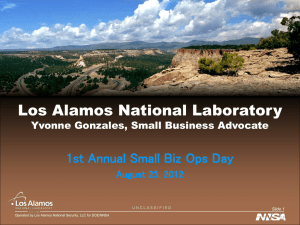
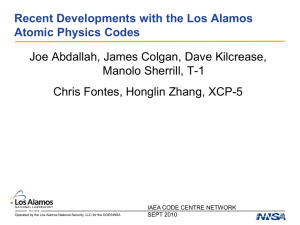
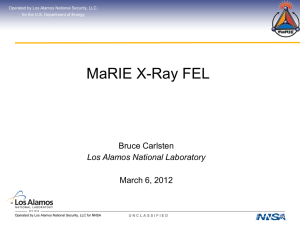

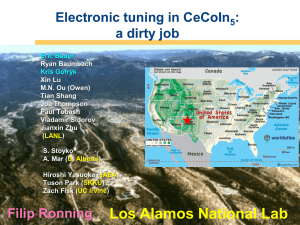
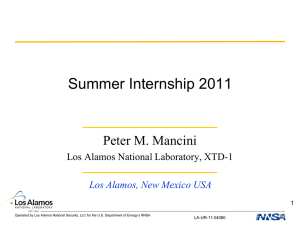
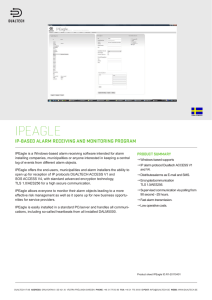
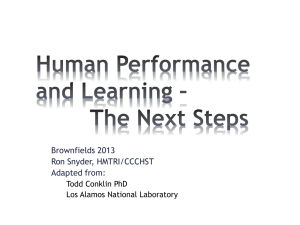
![Your_Solutions_LLC_-_New_Business3[1]](http://s2.studylib.net/store/data/005544494_1-444a738d95c4d66d28ef7ef4e25c86f0-300x300.png)


